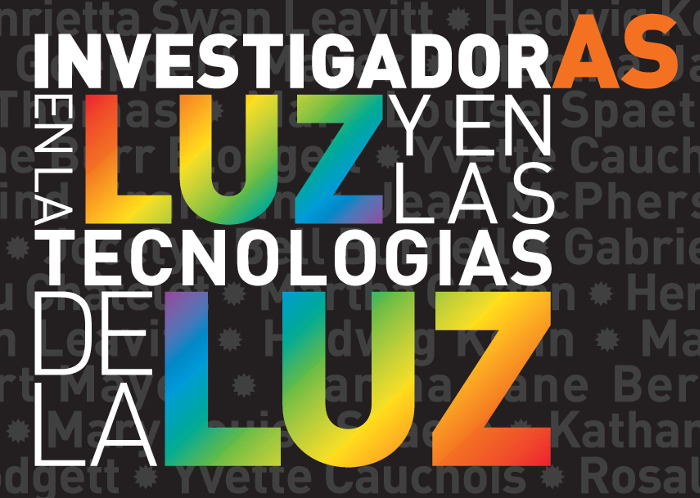Campus Burjassot UV, Vestíbul Facultat de Farmàcia
| Time table: | From Monday to Friday, from 8:00 to 22:00 |

|
Organised:
|
Sociedad Española de Óptica
Grupo "Mujeres en Física"
|
|
Participants "Mujeres en Física":
|
Pascuala García Martínez (coordinadora), UVEG
María del Mar Sánchez López, UMH
Augusto Beléndez Vázquez, UA
Ana Jesús López Díaz, UDC
Amparo Pons Martí, UV
Carmen Carreras Béjar, UNED
Pilar López Sancho, CSIC
María Josefa Yzuel Giménez, UAB
María Luisa Calvo Padilla, UCM
|
 |
| © Celestí Crespo |
On 20 December 2013 the General Assembly of the United Nations declared 2015 as International Year of Light and of the Light-Based Technologies, in order to bring to life the key role that light and the technologies related it play in all human activities. It is enough to look around us to realise that the many applications of light have revolutionised society through science, engineering, architecture, medicine, energy, communications, culture, art and leisure.
Two objectives of this declaration are “promoting the empowerment of women in science” and “promoting scientific vocations in the field of light and its applications”. With these two motivations, a group of people from the Women in Physics Group of the Royal Spanish Society of Physics (RSEF) and the Spanish Society of Optics (SEDOPTICA) have been working to make visible the work of some women researchers who have significantly contributed to the development of the scientific field of light and to these women we want to dedicate the exhibition “Investigadoras en la Luz y en las Tecnologías de la Luz”. Furthermore, it is unquestionable that by giving visibility to women scientists and highlighting their contributions in the progress of optical and photonic technologies in our Society, we will create referents for our future generations.
There are many important milestones in the history of light science that we will celebrate this year, and behind them we always find the name of a researcher: Alhazen, Fresnel, Maxwell, Einstein, Penzias, Wilson and Kao. All of them men.
 |
| © Celestí Crespo |
However, it is absurd to think that the other half of humanity has been absent in the evolution of scientific discoveries. Along the History of Science, there have been brave and brilliant women who, despite the explicit prohibition and the constant denial of their vocation, knew how to make their way and have illuminated us with their discoveries about light. It is now time to illuminate them and we want this exhibition to be a tribute to them.
Thanks to the erudition of Madame de Châtelet and her translation of the “Principia Mathematica” the European continent could gain access to Newton’s theories. Martha Coston was the first to design and build a communication system based on flares for boats, contributing to save many lives. Henrietta Swan Leavitt discovered the way to know the size of our galaxy and the scale of the universe. Hedwig Kohn made a meticulous work in spectrometry and pyrometry, nowadays considered illumination standards. Katharine Burr Blodgett invented the anti-reflective crystals, while Yvette Cauchois created an X-ray spectroscopy which permitted to discover new periodic elements. Maria Goeppert Mayer gave name to the section unit of absorption of two photons and Mary Louise Spaeth invented the tunable dye laser and developed the laser rangefinders. Rosalind Franklin obtained the famous Photography 51, which experimentally proved the helicoidal structure of DNA through the diffraction of X-rays. Martha Jane Bergin Thomas improved the illumination sources, especially light bulbs and fluorescent tubes and Jean McPherson Bennet provided original ideas which are referent in the study of optical surfaces. Finally, Jocelyn Bell Burnell discovered the “headlamps” of the universe, pulsars.
These are only a small sample of all our researchers who have worked, work and will work in the science of light, optics and light-based technologies. It is our obligation as a scientific society to bring them to light and to make known their contributions and model aspects of their lives. What time would be better to do this that this “International Year of Light and Light-Based Technologies”.
 |
| © Celestí Crespo |











